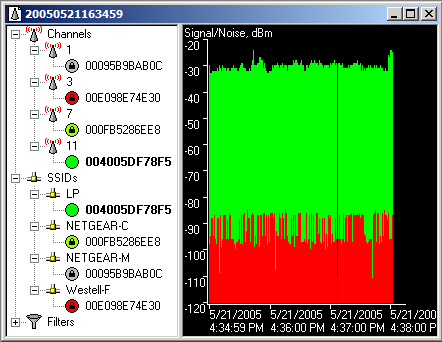As you see in the window on the left, Netstumbler has detected four WiFi access points, transmitting on channels 1, 3, 7 and 11. The signal to noise ratio is highest for the access point on channel 11 which is the one in my house.
The noise is due to the fact that the radio channels are not perfectly separated. The signal in a given channel is centered around a frequency, but some energy is radiated at higher and lower frequencies. For example, WiFi (802.11b and g) divides the spectrum into 11 channels with center frequencies 5 megahertz (MHz) apart. Channel 1 centers on 2,412 MHz, channel 2 on 2,417 MHz, etc.
(Due to the spread spectrum modulation scheme, each data link actually uses 22 Mhz, so only channels 1, 6 and 11 are typically used).
